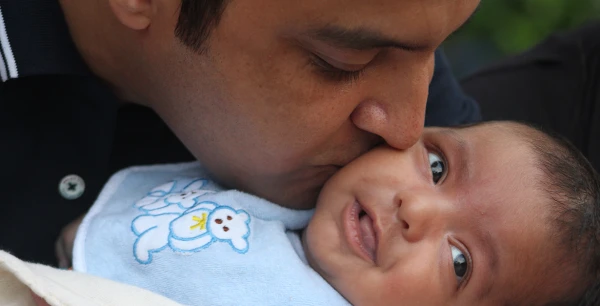 If you’ve read my book, you know that sleep is a fascinating subject (or at least it is to me). It’s a developmental area that undergoes an incredible metamorphosis as your child grows. Sleep is amazing, and it’s something that we all need to function. Interestingly, the ability to put yourself to sleep is also something that isn’t ingrained in us. This ability has to be taught to our children. Although sleep is a natural ability that we are born with, the falling asleep part needs development. This is why newborns need so much help falling asleep.
If you’ve read my book, you know that sleep is a fascinating subject (or at least it is to me). It’s a developmental area that undergoes an incredible metamorphosis as your child grows. Sleep is amazing, and it’s something that we all need to function. Interestingly, the ability to put yourself to sleep is also something that isn’t ingrained in us. This ability has to be taught to our children. Although sleep is a natural ability that we are born with, the falling asleep part needs development. This is why newborns need so much help falling asleep.
Understanding that knowing how to fall asleep is a skill we are not born with goes a long way to understanding why parents sleep coach. There are a few facts that will help you to understand why babies need to learn to fall asleep on their own, and when you can start to sleep coach.
Newborns Sleep A LOT
Newborns sleep a majority of the time, and this sleep is necessary to their development. In fact, your baby doesn’t even begin to develop adult sleep patterns until sometime between 4 and 5 months. Interestingly, a baby’s sleep patterns don’t mimic an adults until they are 2 years old. For this reason, I do not recommend sleep coaching a baby younger than 6 months. In fact, I encourage parents to follow the baby’s lead, and allow her to sleep as much as possible to help her growth.
Remember that sleep is a learned skill, and your newborn baby does not know how to fall asleep by himself. You will need to help encourage sleep by promoting a dark, quiet room for your baby to sleep in (including naps).
Your Baby’s Bedtime May Be Earlier Than You Think
I cannot count the number of families who have contacted me for help, and are at their wit’s end with their baby’s sleep habits-especially an extremely late bedtime. Many parents think a late bedtime (such as 9:00 p.m., 11:00 p.m., or even midnight) is normal or will help their baby sleep better during the night or sleep later in the morning, when in fact a much more biologically appropriate bedtime for our children is between 7:00 and 8:00 p.m., depending on your baby’s age and amount of daytime sleep he gets. In fact, children who fight sleep, or resist bedtime are often overtired, and lacking daytime sleep.
Naps are Necessary
We all know that babies need both daytime sleep and nighttime sleep. Many parents don’t realize that naps actually allow our children to sleep well at night. If your child is not napping during the day, she may be overly tired, cranky and an outright handful.
Make sure that you aren’t exceeding your child’s wakefulness windows during the day, which will help reduce resistance to nighttime sleep and naps. Having extended wakefulness windows may actually contribute to early rising, so if your child has been waking up at 5 a.m. on the dot, you may want to adjust his naps and bedtime to better fit with the average wakefulness window according to his age.
Crying is Normal
I think that it’s important to note that the following thoughts about crying does not apply to newborn babies (newborns really should not be sleep coached).
It’s sad, but true. I think that many parents judge their parenting worth based on whether or not they can keep the baby calm. What we forget is that crying is a normal part of development, and we sometimes overcompensate by attempting to stop our babies cries by any means possible-with sleep, this often means creating a sleep crutch, which really just teaches your baby that if she cries, you’ll come running and then she gets held.
As I stated in my article about Attachment Parenting and Sleep Coaching: “Sleep coaching does not mean letting your child sob for hours on end. Crying is a normal part of childhood, and some children do fuss a bit during gentle sleep coaching, but you are right there to calm and soothe your baby as they learn how to fall asleep with both verbal and physical reassurance.”
While snuggling with your baby is a great way to bond, immediately responding to frustrated cries by attempting to replace them with an inadvertent sleep crutch is only going to prolong the crying.
A note from The Sleep Lady: Crying is a tough topic-and as a parent, I hated to hear my girls cry. Remember, it’s what you do when you respond to your baby’s crying that matters: if you can find the source of the tears, such as frustration that she can’t reach her blankie, or a wet diaper, you can determine how to respond, and avoid creating a sleep crutch.
At some point, the sleep crutch is going to stop working, and your baby is going to expect you to figure something else out, or you’ll want to break the sleep crutch. Maybe if we remember that crying is simply how our baby is able to communicate, we can remind ourselves that instead of just focusing on stopping the crying, we need to figure out why. If we can find the reason behind the cries (such as exhaustion, a lost pacifier, or trouble falling to sleep), we can help her to problem solve with reassurance and support, rather than doing it for her.
Routines are Important
I am constantly stressing the need for a soothing, relaxing bedtime routine, but having a predictable daytime routine is just as important. Your baby thrives on routines and consistency, so having a flexible schedule for your baby’s meals, playtimes, and naps is just as important as a good bedtime routine.
Explain The Coaching Process
We often forget that our children understand far more language than we give them credit for. Talk your child through upcoming changes, and explain what’s going to happen before you make a change to the schedule or routine.
Additionally, remember to be available and accessible to your child at naptimes and bedtime while she’s learning to fall asleep. That means that you will have a supporting role, and are available to help teach and encourage through positive words and touch.
What was the most surprising thing about your sleeping baby?
Was this article helpful to you? Please tell us by commenting below! For more baby, toddler, and family sleep tips and tricks, please subscribe to The Sleep Lady’s Facebook, Twitter, Pinterest, Google+, and YouTube channel! If you are looking for more sleep content, please check out Get Sleep Now-an exclusive members-only area designed to provide in-depth help and support during your sleep coaching experience.
photo credit: chmeredith via photopin cc


